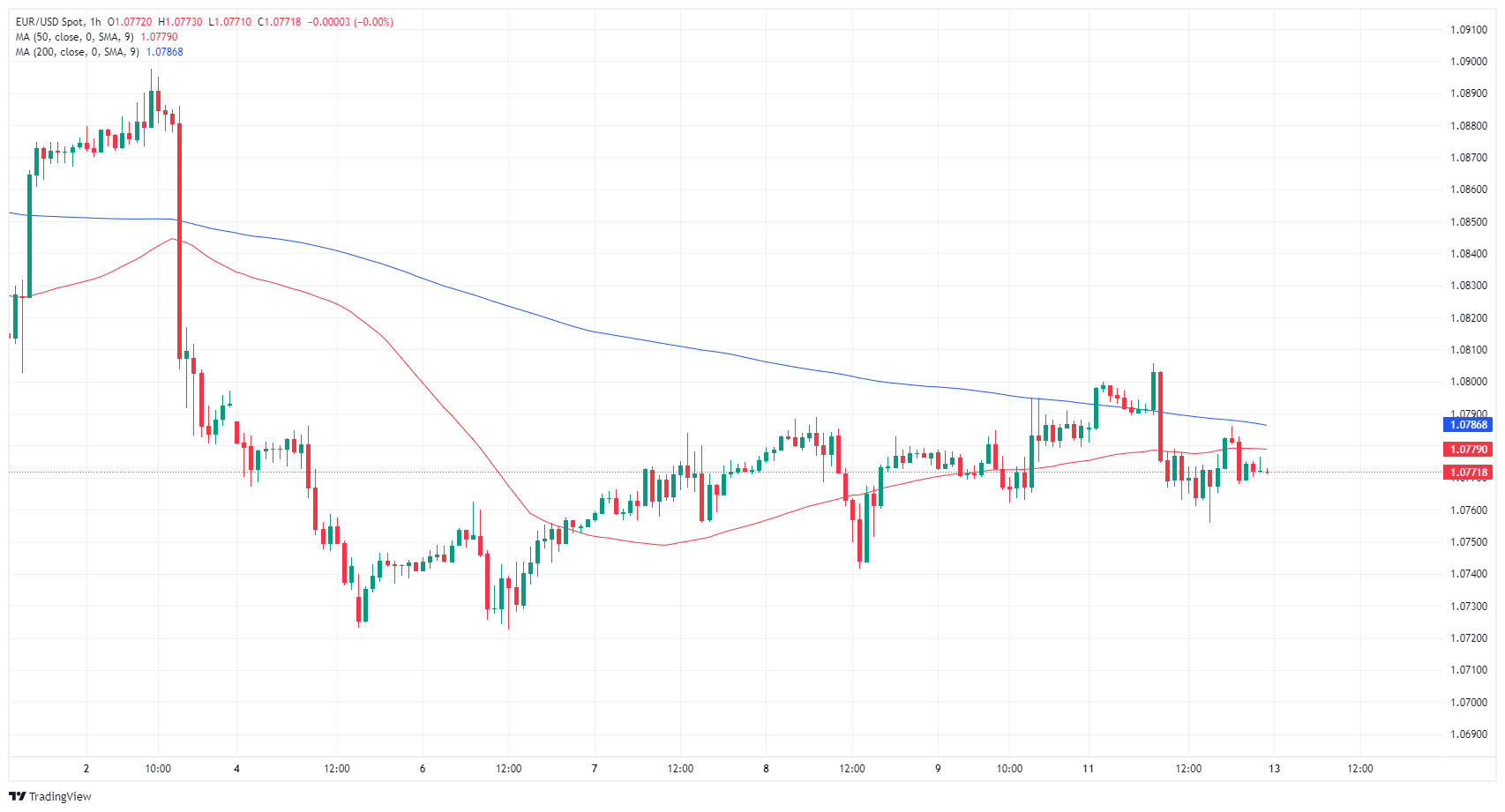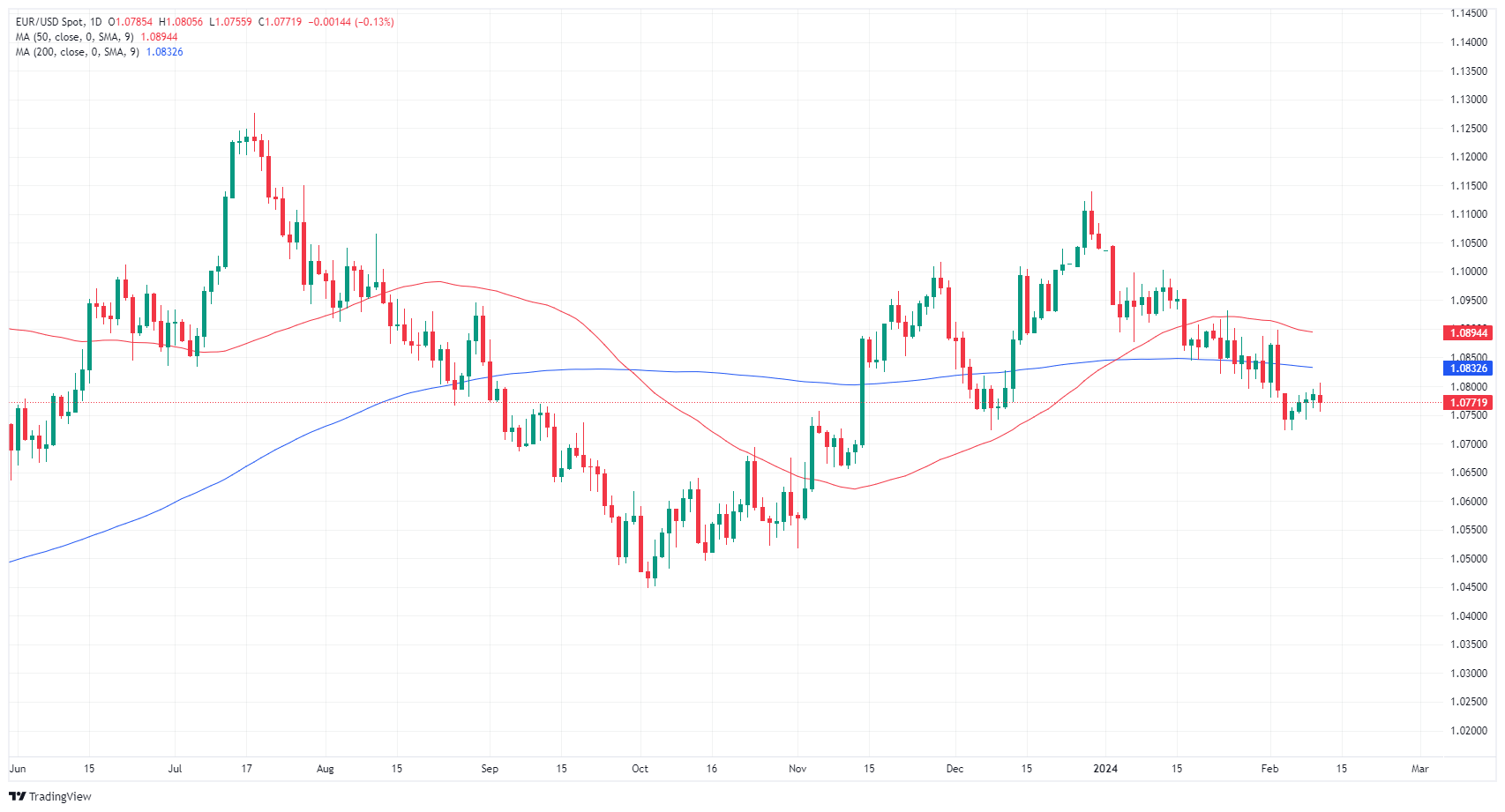- EUR/USD continues to grapple with 1.0800.
- Euro area GDP figures due in the midweek, after Tuesday’s US CPI inflation.
- An appearance from ECB President Lagarde due later in the week.
EUR/USD tested 1.0800 on Monday, but broad-market flows remain tepid in thin action to kick off the new trading week. A light data calendar on Monday will give way to a fresh print of US Consumer Price Index (CPI) inflation figures on Tuesday, and investors will be keeping a close eye on price growth figures from the US.
The euro area sees Gross Domestic Product (GDP) figures on Wednesday, to be followed by an appearance from European Central Bank (ECB) President Christine Lagarde on Thursday. The US’ Tuesday CPI inflation gives way to US Retail Sales on Thursday.
Daily digest market movers: EUR/USD capped by descending 200-day SMA as markets await data
- Quiet Monday leaves EUR/USD constrained in a familiar midrange.
- Bullish momentum remains capped by median technical barriers.
- Higher lows continue to push higher despite constrained momentum.
- Tuesday’s US YoY Core CPI inflation is expected to tick down to 3.7% from 3.9%.
- January’s MoM CPI headline inflation forecast to hold steady at 0.2% after the Bureau of Labor Statistics introduced changed seasonal adjustment methods, December’s figure gets revised down from 0.3%.
- Euro area GDP growth is broadly forecast to hold steady at 0.11% for the year ended in the fourth quarter.
- US Retail Sales expected to ease -0.1% in January compared to December’s 0.6% gain.
Euro price this week
The table below shows the percentage change of Euro (EUR) against listed major currencies this week. Euro was the strongest against the New Zealand Dollar.
| USD | EUR | GBP | CAD | AUD | JPY | NZD | CHF | |
| USD | 0.25% | 0.09% | -0.03% | -0.04% | 0.10% | 0.33% | 0.17% | |
| EUR | -0.25% | -0.16% | -0.28% | -0.30% | -0.15% | 0.07% | -0.05% | |
| GBP | -0.08% | 0.16% | -0.11% | -0.12% | 0.01% | 0.24% | 0.09% | |
| CAD | 0.03% | 0.28% | 0.11% | -0.04% | 0.13% | 0.34% | 0.21% | |
| AUD | 0.04% | 0.29% | 0.12% | 0.01% | 0.14% | 0.36% | 0.23% | |
| JPY | -0.10% | 0.15% | 0.03% | -0.12% | -0.13% | 0.23% | 0.07% | |
| NZD | -0.32% | -0.07% | -0.23% | -0.35% | -0.36% | -0.22% | -0.15% | |
| CHF | -0.17% | 0.05% | -0.10% | -0.21% | -0.23% | -0.08% | 0.14% |
The heat map shows percentage changes of major currencies against each other. The base currency is picked from the left column, while the quote currency is picked from the top row. For example, if you pick the Euro from the left column and move along the horizontal line to the Japanese Yen, the percentage change displayed in the box will represent EUR (base)/JPY (quote).
Technical analysis: EUR/USD drives in circles on Monday as 1.0800 proves too slippery
EUR/USD climbed into 1.0800 for the first time since falling back below the key handle in early February. The pair has been steadily grinding higher from February’s early lows near 1.0720, buit steady momentum into the upside sees plenty of technical resistance.
The pair remains capped by the 200-hour Simple Moving Average (SMA), and Monday’s test above 1.0800 saw the EUR/USD quickly rejected back into the 1.0770 region.
Despite four straight days of gains for the EUR/USD, the pair remains on the bearish side of the 200-day SMA near 1.0830. The EUR/USD remains down over 3% from December’s peak bids near 1.1150, and a bearish trend sees little topside potential for the pair as the 50-day SMA turns bearish and is set for a downside crossover of the 200-day SMA.
EUR/USD hourly chart
EUR/USD daily chart
Euro FAQs
What is the Euro?
The Euro is the currency for the 20 European Union countries that belong to the Eurozone. It is the second most heavily traded currency in the world behind the US Dollar. In 2022, it accounted for 31% of all foreign exchange transactions, with an average daily turnover of over $2.2 trillion a day.
EUR/USD is the most heavily traded currency pair in the world, accounting for an estimated 30% off all transactions, followed by EUR/JPY (4%), EUR/GBP (3%) and EUR/AUD (2%).
What is the ECB and how does it impact the Euro?
The European Central Bank (ECB) in Frankfurt, Germany, is the reserve bank for the Eurozone. The ECB sets interest rates and manages monetary policy.
The ECB’s primary mandate is to maintain price stability, which means either controlling inflation or stimulating growth. Its primary tool is the raising or lowering of interest rates. Relatively high interest rates – or the expectation of higher rates – will usually benefit the Euro and vice versa.
The ECB Governing Council makes monetary policy decisions at meetings held eight times a year. Decisions are made by heads of the Eurozone national banks and six permanent members, including the President of the ECB, Christine Lagarde.
How does inflation data impact the value of the Euro?
Eurozone inflation data, measured by the Harmonized Index of Consumer Prices (HICP), is an important econometric for the Euro. If inflation rises more than expected, especially if above the ECB’s 2% target, it obliges the ECB to raise interest rates to bring it back under control.
Relatively high interest rates compared to its counterparts will usually benefit the Euro, as it makes the region more attractive as a place for global investors to park their money.
How does economic data influence the value of the Euro?
Data releases gauge the health of the economy and can impact on the Euro. Indicators such as GDP, Manufacturing and Services PMIs, employment, and consumer sentiment surveys can all influence the direction of the single currency.
A strong economy is good for the Euro. Not only does it attract more foreign investment but it may encourage the ECB to put up interest rates, which will directly strengthen the Euro. Otherwise, if economic data is weak, the Euro is likely to fall.
Economic data for the four largest economies in the euro area (Germany, France, Italy and Spain) are especially significant, as they account for 75% of the Eurozone’s economy.
How does the Trade Balance impact the Euro?
Another significant data release for the Euro is the Trade Balance. This indicator measures the difference between what a country earns from its exports and what it spends on imports over a given period.
If a country produces highly sought after exports then its currency will gain in value purely from the extra demand created from foreign buyers seeking to purchase these goods. Therefore, a positive net Trade Balance strengthens a currency and vice versa for a negative balance.
Information on these pages contains forward-looking statements that involve risks and uncertainties. Markets and instruments profiled on this page are for informational purposes only and should not in any way come across as a recommendation to buy or sell in these assets. You should do your own thorough research before making any investment decisions. FXStreet does not in any way guarantee that this information is free from mistakes, errors, or material misstatements. It also does not guarantee that this information is of a timely nature. Investing in Open Markets involves a great deal of risk, including the loss of all or a portion of your investment, as well as emotional distress. All risks, losses and costs associated with investing, including total loss of principal, are your responsibility. The views and opinions expressed in this article are those of the authors and do not necessarily reflect the official policy or position of FXStreet nor its advertisers. The author will not be held responsible for information that is found at the end of links posted on this page.
If not otherwise explicitly mentioned in the body of the article, at the time of writing, the author has no position in any stock mentioned in this article and no business relationship with any company mentioned. The author has not received compensation for writing this article, other than from FXStreet.
FXStreet and the author do not provide personalized recommendations. The author makes no representations as to the accuracy, completeness, or suitability of this information. FXStreet and the author will not be liable for any errors, omissions or any losses, injuries or damages arising from this information and its display or use. Errors and omissions excepted.
The author and FXStreet are not registered investment advisors and nothing in this article is intended to be investment advice.
Recommended content
Editors’ Picks
AUD/USD sticks to half-yearly highs of 0.6740 ahead of US NFP

AUD/USD consolidates near a multi-month peak at 0.6740 in the Asian session on Friday as traders keenly await the the US NFP report. The Fed-RBA policy divergence continues to underpin the pair.
USD/JPY falls hard toward 160.50, US NFP data awaited

USD/JPY is falling hard toward 160.50 in Asian trading on Friday, having reversed from near 161.40. The pair drops on renewed US Dollar weakness and Japanese verbal intervention, which rescues the Yen. The focus shifts to US jobs report.
Gold price steadily climbs back closer to two-week high, focus remains glued to US NFP

Gold price extends its consolidative price move during the Asian session on Friday and remains well within the striking distance of the highest level since June 21 touched earlier this week. The recent softer US macro data reaffirmed market bets that the Federal Reserve will begin cutting rates in September.
Is the party over for meme coins?

According to Santiment's data on Thursday, meme coins have experienced steep declines in the past few weeks, following speculation that the crypto market has passed its euphoria phase.
US jobs report preview – Will Nonfarm Payrolls disappoint?

Will the July Nonfarm Payrolls report disappoint, sending stocks and the US Dollar lower? Let's take a look at what the signal is from the other labor market indicators because forex fundamentals matter for trading.